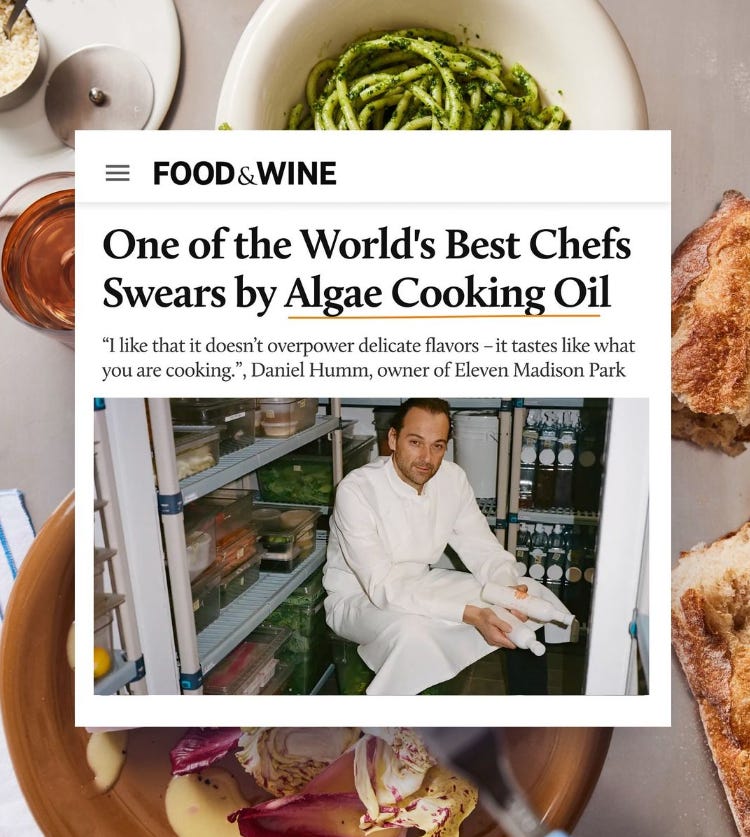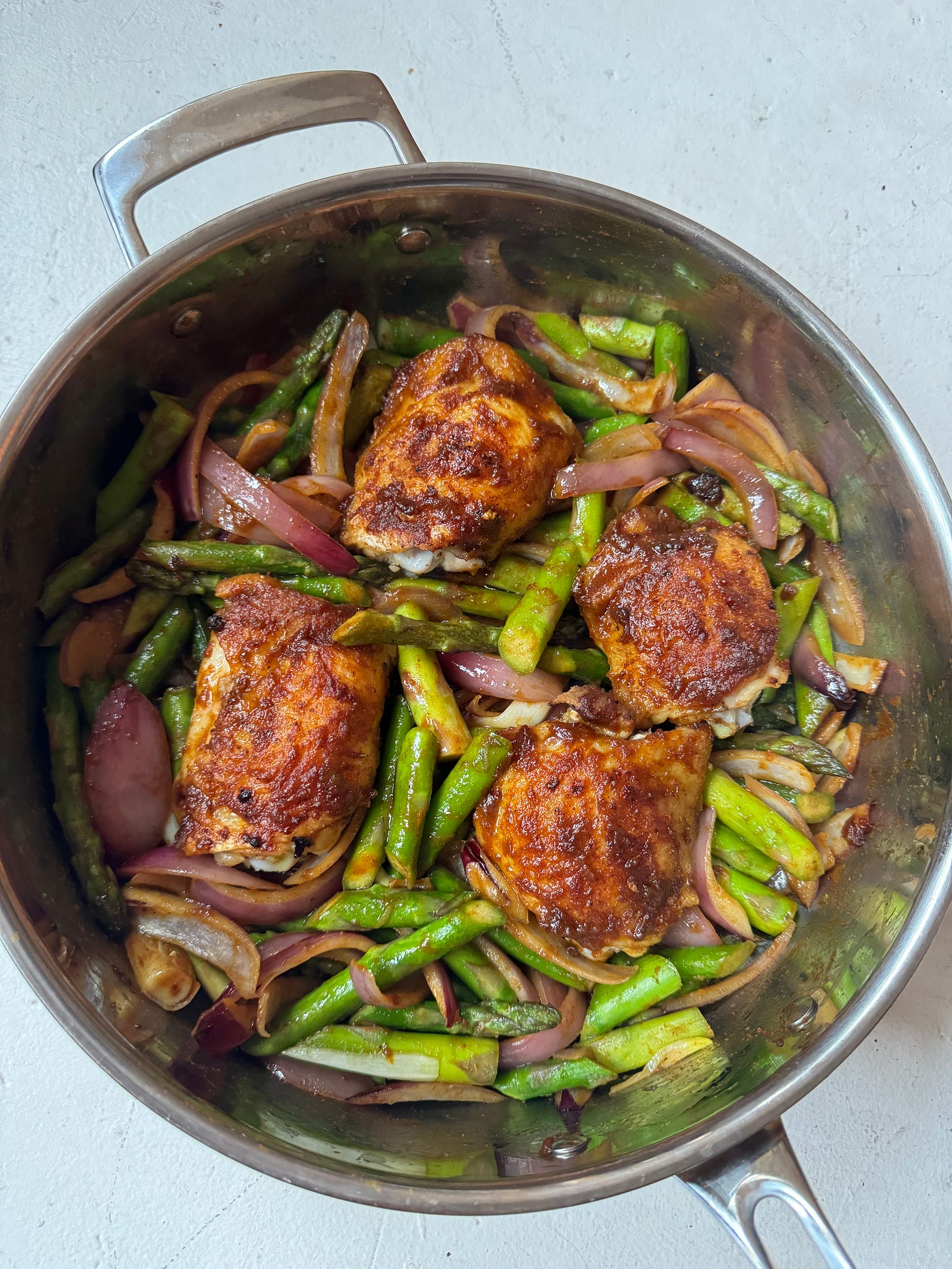Nourish: Thai Curry Chicken and Asparagus Recipe
Featuring a very cool and nutritious cooking oil that deserves a spot in your pantry.
Spring has finally arrived, ushering in a bounty of new seasonal ingredients that decorate the shelves of our farmer’s markets and grocery stores with their vibrancy. It’s a time when nature seems to align perfectly with our nutritional needs, offering us a variety of fresh produce to nourish our bodies in the way we most need it.
In Ayurveda, this harmonious relationship between our diet and the seasons is known as Ritucharya. Embracing this practice not only benefits our physical health but also enhances our connection to the natural world around us.
Eating seasonally and locally ensures that we consume foods at their peak nutritional value. As produce reaches maturity on the plant, it becomes not only more flavorful but also more nutrient-rich. Additionally, this practice supports environmental sustainability by promoting crop diversity and healthy soil management practices, thus mitigating the harmful effects of monocropping.
For migrant communities, advocating for seasonal and local eating becomes especially meaningful. By patronizing farmer’s markets, we directly support the livelihoods of migrant workers who labor to harvest these foods. In doing so, we contribute to their economic stability and advocate for migrant rights.
Today's recipe showcases one of spring's treasures: asparagus. This versatile vegetable, abundant in April, is packed with essential nutrients like vitamin A and vitamin C. Given that April often brings fluctuating weather conditions that can compromise our immune systems, incorporating vitamin C-rich foods like asparagus can help bolster our defenses against common colds and seasonal illnesses.
However, the true star of this recipe is a new pantry staple—the Algae Cooking Club. This innovative alternative to traditional seed cooking oils not only revolutionizes our approach to cooking but also emphasizes sustainability. By utilizing algae-based oils, we not only enhance the flavor of our dishes but also reduce our environmental footprint, aligning with our commitment to responsible consumption.
In essence, embracing seasonal eating not only benefits our health but also fosters a deeper connection to our environment and supports the well-being of our communities, both locally and globally.
Before we get cooking and learn more about Algae Cooking Club, a special thanks to our 12 new subscribers! I see you and I appreciate you!
Okay, heat up your pans and take out your knives, it’s time to get cooking.
When I was approached to try Algae Cooking Club, I seized the opportunity to ask its co-founder, Kasra Saidi, a few questions about this innovative oil. After all, when introducing something new into our diets, it's essential to understand its origins and benefits.
Why did you choose algae as the main ingredient for this oil?
We were looking for a pure, high quality cooking oil. It turns out that algae is the mother of all plants, and where oil in nature originated. If you want the best quality, go straight to the source!
This oil has the highest concentration of good Omega-9 fats (93%) which is higher than both olive and avocado oil (~70%) it also has a fraction of Omega-6 polyunsaturated fats that many people are trying to avoid (~ 3%!) because it is believed to be inflammatory when consumed in excess and oxidize at high heat. And because of algae oil's purity it is extremely stable, it has a 535 degree smoke point and roughly 5X the oxidative stability as avocado oil.
Where did the inspiration come from?
I was working at a venture studio, Squared Circles, which loves to find new ingredients that are better for people and the planet. Algae is one of those ingredients that is quickly becoming a go-to as food systems start to break down due to climate change. It has roughly half the carbon footprint of avocado, canola and olive oil because it's extremely efficient at producing oil. We use a fermentation process that only takes a few days, just like you would brew beer or ferment wine so it's highly controlled and pure.
As an entrepreneur, what is your intent in pulling this new product into the world?
Prove that people are far more open-minded than we give each other credit for. There are a lot of conversations that humans resist change. We like to think we are actually far more open-minded, just look at the rise of mushroom everything over the last three years - it went from lonely vegetable to ingredient super power. We want algae to be an ingredient super power that anyone, not just foodies and health coaches, are adding to their pantry.
Indeed, algae is a powerhouse ingredient, boasting an impressive array of nutrients including dietary fiber, omega-3 and omega-6 fatty acids, and a wide range of vitamins (such as A, C, D, E, K, and various B vitamins), as well as essential minerals like iron, calcium, magnesium, and potassium. Microalgae, in particular, are rich sources of protein, with red algae containing 50–70% protein by dry weight, encompassing all nine essential amino acids. This positions algae as valuable protein sources equivalent to those derived from animal products.
Moreover, according to an article by Medical News Today, Monique Richard, a national spokesperson for the Academy of Nutrition and Dietetics and owner of Nutrition-In-Sight in Johnson City, TN, highlights the chelating benefits of algae. This refers to the ability of algae's minerals to bind to metal ions, effectively removing them from water. This quality can contribute to cleaning wastewater and runoff, thereby promoting sustainability and safeguarding aquaculture systems. It also presents opportunities for enhancing agricultural practices by increasing available resources.
As someone committed to mindful consumption and its impact on both personal health and the environment, I am thrilled to witness the emergence of Algae Cooking Club in the industry. With influential founding members like Sophia Roe, an innovative chef (and fashion icon honestly), endorsing its mission, the club's rapid growth signals a promising future in revolutionizing culinary practices while promoting sustainability.
Thai Curry Chicken and Asparagus
Serves 2-4
Ingredients
1.5 lb skin on, bone in chicken thighs (around 4 thighs)
3 Tablespoons Thai yellow curry paste
2 Tablespoons fish sauce
1 Tablespoon brown sugar, packed
3 Tablespoons Algae Cooking Club, divided
8 oz asparagus, trimmed and cut on the diagonal into 1-inch pieces
1 medium red onion, halved and cut into ½-inch wedges
Sea salt and ground black pepper
Method
Preheat your oven to 400F and set your chicken out on the counter to come to room temperature for about 20 minutes. This is safe to do and helps with even cooking.
Pat the chicken dry with paper towels. Then season on each side with salt and pepper.
In a small bowl, stir together the curry paste, fish sauce, and brown sugar.
Warm a 12-inch cast iron skillet on medium-high heat. Once hot, add 2 tablespoons of Algae Cooking Club oil. When the oil is simmering, add your chicken skin side down and sear for 5-7 minutes until they are nice and golden brown. Do not move the chicken at all during this time. Once ready, flip the thighs. When you flip your chicken, it should give right away. If it’s sticking to your pan, they are not seared all the way yet.
Once the chicken is seared and the skin side is facing up add your chicken to the oven. Cook for 20 minutes.
After 20 minutes, remove the chicken from the oven and using a culinary brush or a spoon marinade the chicken with your Thai curry paste mixture on both sides. Place the chicken with skin facing up back into the skillet and back in the oven for an additional 10 minutes.
Heat a medium deep skillet over medium heat. Add the remaining 1 tablespoon of ACC until simmering. Add the asparagus and onion; cook, without stirring, until browned on the bottom, about 2 minutes. Add the remaining Thai curry paste mixture; cook, stirring, until the sauce has thickened slightly and the vegetables are tender-crisp for about 1 minute. Off heat, taste and season with salt and pepper.
Remove the chicken from the oven and let rest for 10 minutes. Once the chicken is ready, remove it from the cast-iron skillet and dump all the delicious juices left at the bottom into your asparagus and onion, mixing well to incorporate.
Serve over rice garnished with fresh cilantro and lime wedges.





